What Do You Associate With the Art of Ancient Egypt?
Fine art is an essential attribute of any civilisation. Once the bones human needs have been taken intendance of such every bit food, shelter, some form of community police force, and a religious belief, cultures brainstorm producing artwork, and often all of these developments occur more than or less simultaneously. This process began in the Predynastic Menstruum in Egypt (c. 6000 - c. 3150 BCE) through images of animals, human beings, and supernatural figures inscribed on stone walls. These early images were crude in comparison to after developments simply all the same limited an important value of Egyptian cultural consciousness: balance.
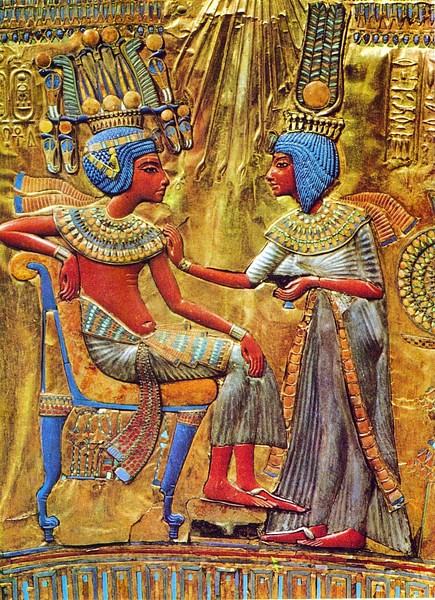
Tutankhamun & Ankhsenamun
Egyptian society was based on the concept of harmony known as ma'at which had come up into beingness at the dawn of creation and sustained the universe. All Egyptian fine art is based on perfect balance because it reflects the platonic world of the gods. The aforementioned way these gods provided all skilful gifts for humanity, so the artwork was imagined and created to provide a use. Egyptian art was always first and foremost functional. No matter how beautifully a statue may have been crafted, its purpose was to serve equally a home for a spirit or a god. An amulet would have been designed to be attractive simply aesthetic beauty was not the driving force in its creation, protection was. Tomb paintings, temple tableaus, home and palace gardens all were created and so that their form suited an important role and, in many cases, this part was a reminder of the eternal nature of life and the value of personal and communal stability.
Early Dynastic Period Fine art
The value of residue, expressed as symmetry, infused Egyptian art from the earliest times. The stone art from the Predynastic Menstruum establishes this value which is fully developed and realized in the Early Dynastic Menstruation of Egypt (c. 3150 - c. 2613 BCE). Fine art from this menses reaches its height in the piece of work known as The Narmer Palette (c. 3200-3000 BCE) which was created to gloat the unity of Upper and Lower Egypt under King Narmer (c. 3150 BCE). Through a series of engravings on a siltstone slab, shaped as a chevron shield, the story is told of the great king'due south victory over his enemies and how the gods encouraged and approved his actions. Although some of the images of the palette are difficult to interpret, the story of unification and the commemoration of the male monarch is quite clear.
![Narmer Palette [Two Sides]](https://www.worldhistory.org/img/r/p/500x600/4412.jpg?v=1649972822)
Narmer Palette [Two Sides]
On the front, Narmer is associated with the divine forcefulness of the bull (possibly the Apis Bull) and is seen wearing the crown of Upper and Lower Arab republic of egypt in a triumphal procession. Below him, two men wrestle with entwined beasts which are oftentimes interpreted every bit representing Upper and Lower Egypt (though this view is contested and there seems no justification for it). The reverse side shows the king's victory over his enemies while the gods look on approvingly. All these scenes are carved in low-raised relief with incredible skill.
This technique would exist used quite effectively toward the end of the Early Dynastic Period past the builder Imhotep (c. 2667-2600 BCE) in designing the pyramid complex of King Djoser (c. 2670 BCE). Images of lotus flowers, papyrus plants, and the djed symbol are intricately worked into the architecture of the buildings in both high and low relief. By this time the sculptors had also mastered the art of working in stone to created three-dimensional life-sized statues. The statue of Djoser is amongst the greatest works of fine art from this period.
Onetime Kingdom Fine art
This skill would develop during the Old Kingdom of Arab republic of egypt (c. 2613-2181 BCE) when a strong key government and economic prosperity combined to let for monumental works like the Not bad Pyramid of Giza, the Sphinx, and elaborate tomb and temple paintings. The obelisk, offset adult in the Early Dynastic Flow, was refined and more widely used during the One-time Kingdom. Tomb paintings became increasingly sophisticated but statuary remained static for the about part. A comparison betwixt the statue of Djoser from Saqqara and a small-scale ivory statue of King Khufu (2589-2566 BCE) found at Giza display the same grade and technique. Both of these works, withal, are exceptional pieces in execution and particular.
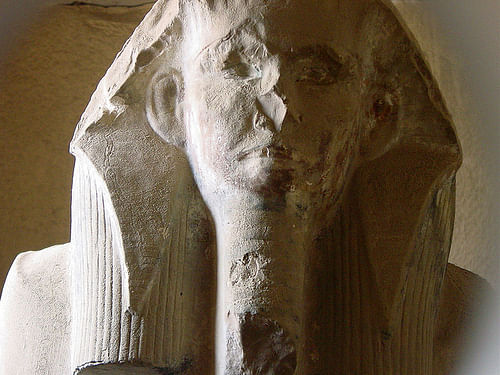
Djoser
Fine art during the Former Kingdom was country mandated which ways the king or a high-ranking nobility commissioned a piece and also dictated its style. This is why there is such uniformity in Onetime Kingdom artwork: dissimilar artists may take had their own vision but they had to create in accord with their client'southward wishes. This paradigm changed when the Old Kingdom collapsed and initiated the First Intermediate Period (2181-2040 BCE).
Art in the First Intermediate Period
The Showtime Intermediate Period has long been characterized as a time of chaos and darkness and artwork from this era has been used to substantiate such claims. The argument from art rests on an estimation of Kickoff Intermediate Period works every bit poor quality every bit well equally an absence of monumental building projects to prove that Egyptian culture was in a kind of free fall toward anarchy and dissolution. In reality, the First Intermediate Catamenia of Egypt was a time of tremendous growth and cultural change. The quality of the artwork resulted from a lack of a strong key government and the respective absenteeism of land-mandated art.
The quality of the artwork resulted from a lack of a strong central regime & the corresponding absence of state-mandated art.
The different districts were now complimentary to develop their ain vision in the arts and create according to that vision. There is nothing 'low quality' near First Intermediate Period art; it is simply different from Old Kingdom artwork. The lack of awe-inspiring building projects during this time is too easily explained: the dynasties of the Old Kingdom had tuckered the government treasury in creating their ain m monuments and, past the time of the 5th Dynasty, there were no resources left for such projects. The collapse of the Old Kingdom following the 6th Dynasty certainly was a time of confusion, just there is no evidence to propose the era which followed was whatever kind of 'dark age'.
The First Intermediate Period produced a number of fine pieces just also saw the ascension of mass-produced artwork. Items which had previously been made past a single artist were now assembled and painted past a production crew. Amulets, coffins, ceramics, and shabti dolls were among these crafts. Shabti dolls were of import funerary objects which were buried with the deceased and were thought to come to life in the side by side world and tend to one's responsibilities. These were made of faience, stone, or forest but, in the Get-go Intermediate Menses, are by and large of wood and mass produced to be sold cheaply. Shabti dolls were important items because they would allow the soul to relax in the afterlife while the shabti did one's work. Previously, only the wealthy could afford shabti dolls, only in this era, they were bachelor to those of more small-scale means.
Middle Kingdom Art
The First Intermediate Period ended when Mentuhotep II (c. 2061-2010 BCE) of Thebes defeated the kings of Herakleopolis and initiated the Eye Kingdom of Arab republic of egypt (2040-1782 BCE). Thebes at present became the capital letter of Egypt and a strong central government once more had the ability to dictate creative gustation and cosmos. The rulers of the Eye Kingdom, however, encouraged the different styles of the districts and did not mandate that all art conform to the tastes of the dignity. Although there was great reverence for Old Kingdom art and, in many cases, an obvious attempt to reflect information technology, Middle Kingdom Art is distinctive in the themes explored and the sophistication of the technique.
The Centre Kingdom is usually regarded as the high bespeak of Egyptian culture. The tomb of Mentuhotep II is itself a work of fine art, sculpted from the cliffs well-nigh Thebes, which merges seamlessly with the natural landscape to create the upshot of a wholly organic work. The paintings, frescoes, and statuary which accompanied the tomb also reflect a high level of composure and, as always, symmetry. Jewelry was also refined profoundly at this time with some of the finest pieces in Egyptian history dated to this era. A pendant from the reign of Senusret II (c. 1897-1878 BCE) which he gave to his girl is fashioned of thin gilt wires fastened to a solid gilded backing inlaid with 372 semi-precious stones. The statues and busts of kings and queens are intricately carved with a precision and beauty lacking in much of the Old Kingdom artwork.
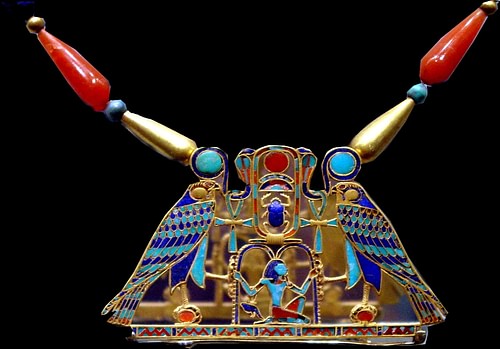
Pectoral of Senusret II
The most striking attribute of Middle Kingdom art, even so, is the subject matter. Common people, instead of nobility, feature more than ofttimes in art from this period than whatever other. The influence of the First Intermediate Flow continues to be seen in all the art from the Heart Kingdom, where laborers, farmers, dancers, singers, and domestic life receive almost equally much attention as kings, nobles, and the gods. Artwork in tombs connected to reverberate the traditional view of the afterlife, just literature from the time questioned the one-time belief and suggested that one should concentrate on the only life one could be sure of, the present.
This emphasis on life on earth is reflected in less idealistic and more realistic artwork. Kings like Senusret Three (c. 1878-1860 BCE) are depicted in statuary and art every bit they really were instead of equally ideal kings. Scholars recognize this by the uniformity and detail of the representations. Senusret Iii is seen in different works at different ages, sometimes looking careworn, sometimes victorious, whereas kings of earlier eras were always shown at the same age (young) and in the same way (powerful). Egyptian art is famously expressionless because the Egyptians recognized that emotions are fleeting and i would non want one'southward eternal image to reverberate only one moment in life but the totality of one'southward existence.
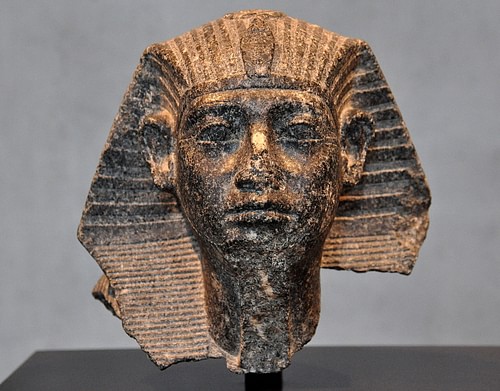
Head of Senusret III
The Eye Kingdom began to dissolve during the 13th Dynasty when the rulers had grown also comfortable and neglected the diplomacy of state. The Nubians encroached from the due south while a foreign people, the Hyksos, gained a substantial foothold in the Delta region of the northward. The government at Thebes lost control of large sections of the Delta to the Hyksos and could practise nothing about the growing ability of the Nubians; it became increasingly obsolete and ushered in the era known every bit the 2nd Intermediate Period (c. 1782 - c. 1570 BCE). During this time the authorities at Thebes continued to committee artwork just on a smaller scale while the Hyksos either appropriated earlier works for their temples or commissioned for grander works.
Second Intermediate Period/New Kingdom Art
The art of the Second Intermediate Menstruation of Arab republic of egypt continued the traditions of the Middle Kingdom but oftentimes less effectively. The all-time artists were available to the nobility at Thebes and produced high-quality work, simply non-imperial artists were less skilled. This era, like the first, is also ofttimes characterized as disorganized and cluttered, and the artwork held up as proof, but in that location were many fine works created during this fourth dimension; they were simply on a smaller scale.
Tomb paintings, statuary, temple reliefs, pectorals, headdresses, and other jewelry of high quality continued to be produced and the Hyksos, though often vilified past later Egyptian writers, contributed to cultural development. They copied and preserved many of the written works of earlier history which are yet extant and also copied statuary and other artworks.
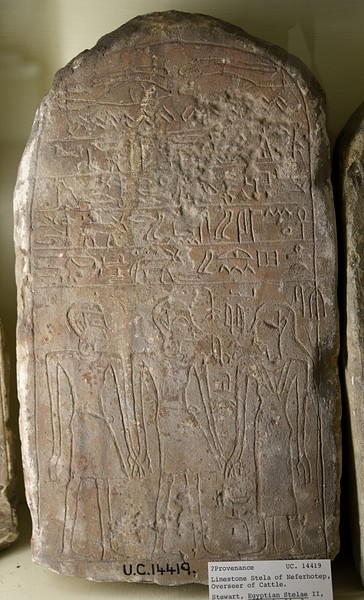
Egyptian Stela of Neferhotep
The Hyksos were finally driven out by the Theban prince Ahmose I (c. 1570-1544 BCE) whose rule begins the period of the New Kingdom of Egypt (c. 1570 - c. 1069 BCE). The New Kingdom is the most famous era of Egyptian history with the best-known rulers and nigh recognizable artwork. The colossal statues which were initiated in the Middle Kingdom became more than mutual during this time, the temple of Karnak with its great Hypostyle Hall was expanded regularly, the Egyptian Book of the Dead was copied with accompanying illustrations for more and more people, and funerary objects like shabti dolls were of higher quality.
Egypt of the New Kingdom is the Egypt of empire. As the borders of the land expanded, Egyptian artists were introduced to different styles and techniques which improved their skills. The metalwork of the Hittites which the Egyptians fabricated use of in weaponry as well influenced art. The wealth of the land was reflected in the enormity of individual artworks too equally their quality. The pharaoh Amenhotep Three (1386-1353 BCE) built and then many monuments and temples that later scholars attributed to him an exceptionally long reign. Among his greatest works are the Colossi of Memnon, two enormous statues of the seated king rising sixty ft (eighteen m) loftier and weighing 720 tons each. When they were built they stood at the entrance to Amenhotep Iii's mortuary temple, which is now gone.
Amenhotep III'south son, Amenhotep 4, is better known as Akhenaten (1353-1336 BCE), the name he chose later devoting himself to the god Aten and abolishing the aboriginal religious traditions of the country. During this time (known every bit the Amarna Period) fine art returned to the realism of the Centre Kingdom. From the outset of the New Kingdom, artistic representations had over again moved toward the platonic. During the reign of Queen Hatshepsut (1479-1458 BCE), although the queen is depicted realistically, most portraits of nobility show the idealism of Sometime Kingdom sensibilities with centre-shaped faces and smiles. The art of the Amarna flow is so realistic that mod-twenty-four hours scholars have been able to reasonably suggest what concrete ailments people in the pictures probably suffered from.
Two of the well-nigh famous works of Egyptian fine art come from this time: the bust of Nefertiti and the gold expiry mask of Tutankhamun. Nefertiti (c. 1370-1336 BCE) was Akhenaten'south wife and her bust, discovered at Amarna in 1912 CE by the German language archeologist Borchardt is almost synonymous with Arab republic of egypt today. Tutankhamun (c.1336-1327 BCE) was Akhenaten'south son (merely not Nefertiti's) who was in the process of dismantling his begetter'due south religious reforms and returning Egypt to traditional behavior when he died earlier the age of 20. He is all-time known for his famous tomb, discovered in 1922 CE, and the vast number of artifacts it contained.
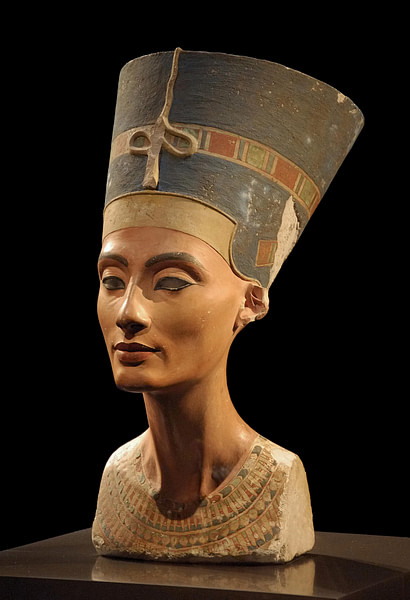
Queen Nefertiti
The gilded mask and other metal objects found in the tomb were all the effect of innovations in metalwork learned from the Hittites. The art of the Egyptian Empire is among the greatest of the civilization because of the Egyptian's interest in learning new techniques and styles and incorporating them. Prior to the arrival of the Hyksos in Egypt, Egyptians thought of other nations equally barbaric and uncivilized and did non consider them worthy of any special attending. The Hyksos 'invasion' forced the people of Egypt to recognize the contributions of others and make use of them.
Later Periods & Legacy
The skills caused would proceed through the Third Intermediate Menstruation of Egypt (c. 1069-525 BCE) and Late Menstruum (525-332 BCE), which are also negatively compared with the grander eras of a strong central government. The style of these after periods was affected by the times and the limited resources, only the art is nevertheless of considerable quality. Egyptologist David P. Silverman notes how "the fine art of this era reflects the opposing forces of tradition and change" (222). The Kushite rulers of the Late Period of Ancient Egypt revived Quondam Kingdom art in an effort to identify themselves with Arab republic of egypt's oldest traditions while native Egyptian rulers and nobility sought to advance artistic representation from the New Kingdom.
This aforementioned paradigm holds with Farsi influence following their invasion of 525 BCE. The Persians also had neat respect for Egyptian culture and history and identified themselves with Old Kingdom art and architecture. The Ptolemaic Period (323-30 BCE) blended Egyptian with Greek fine art to create statuary like that of the god Serapis - himself a combination of Greek and Egyptian gods - and the fine art of the Roman Egypt (thirty BCE - 646 CE) followed this aforementioned model. Romans would draw on the older Egyptian themes and techniques in adapting Egyptian gods to Roman agreement. Tomb paintings from this time are distinctly Roman only follow the precepts begun in the Old Kingdom.
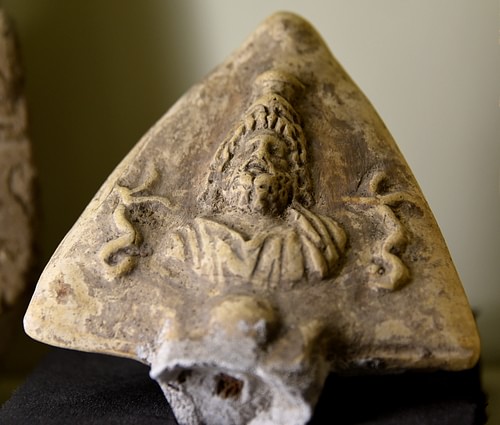
Egyptian Oil Lamp with Serapis
The art of these later cultures would come to influence European understanding, technique, and manner which would exist adhered to for over i,000 years until artists in the late 19th century CE, such every bit the Futurists of Italy, began breaking with the past. So-called Mod Art in the early 20th century CE was an endeavor to strength an audience to run across traditional subjects in a new light. Artists like Picasso and Duchamp were interested in forcing people to recognize their preconceptions about art and, by extension, life in creating unexpected and unprecedented compositions which broke from the past in style and technique. Their works and those of others were only possible, even so, considering of the prototype created past the aboriginal Egyptians.
This article has been reviewed for accuracy, reliability and adherence to academic standards prior to publication.
Source: https://www.worldhistory.org/article/1077/a-brief-history-of-egyptian-art/
0 Response to "What Do You Associate With the Art of Ancient Egypt?"
Postar um comentário